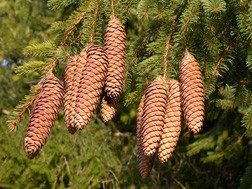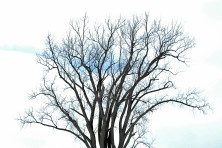Conifer Tree Cones of Winter
- Share
- Tweet
- Pin
- Share

The White Spruce is a two-year cone, staying on the tree for two years before dropping. Photo by Roy Lukes.
Conifer tree cones have played an important part in winter decorations for many years, adding holiday traditions to table and outdoor wreaths, or Christmas tree trimmings. Door Countyites are fortunate to have commonly growing here at least 10 cone-producing conifer tree species. I say conifer rather than evergreen simply because one tree, the Tamarack, which produces beautiful little cones, is a deciduous conifer and loses its needles each fall.
Two of the species, the Norway Spruce and the Scotch Pine (which I prefer to call the Scots Pine), are not native to our continent but have been widely planted, and I strongly suspect are reproducing naturally. The Norway Spruce, native to central and northern Europe, growing as tall as 215 feet, is the predominant tree of the Black Forest in Germany. It may be Europe’s most widely used Christmas tree. Surely its lovely large cones rank among the decorators’ favorites. I’ve used this amazing 4 – 8 inch cone in some of my nature classes dealing with the intriguing spirals of nature. (See page 190 in my book, Tales of the Wild, A Year with Nature.)
The Mountain of European Spruce, or what we call the Norway Spruce, considered to be the largest and hardiest spruce in the world, is also famous for its so-called “cuckoo clock” cones. For a long time many of the cuckoo clock makers of the Black Forest have patterned the weights, designed to wind the clock, after the long symmetrical shape of these cones.

The classical Norway Spruce cones show nature’s spirals to perfection. Photo by Roy Lukes.
As for the beautiful Scotch Pine, I’ll agree to call it Scotch Pine too because nearly everyone else in our country does, including the professional foresters. In Scotland and elsewhere in Europe, from where ours came, it’s the Scots Pine and is the national tree of Scotland.
By the way, you wouldn’t refer to someone from Scotland as being “Scotch.” They are Scots! They might drink Scotch, but they’re Scots!
The Scots Pine is the only pine native to northern Europe where it grows very well and is widely used as a Christmas tree, as it is in our country. Its lovely, tightly packed cones are between three and four inches long.
Often in past years when we used one of our favorite Christmas trees, the Balsam Fir, we were delighted to see the thin upright spike-like or candle-like remains of dozens of the cones in the upper foot or so of the tree. Fir trees have small upright cones that somewhat resemble tiny owls perched on the branches. The cones ripen quickly in such a way that the individual scales, starting at the top of the cone, slough off layer by layer, release their seeds, and fall to the ground. They develop in one year and by winter only their upright “backbones” remain.
In order to gather our native White Pine cones you have to locate some trees that are at least 15 years or older. Plantation-grown White Pines for use as Christmas trees are too young to produce cones; the trees are uncommon today due to the high incidence of the dreaded White Pine Blister Rust disease. Relatively few of these beautiful pines are planted today. I consider their four-to-six-inch cones to be the classic shape for conifer cones used in decorations. Should you be fortunate to find some in the wild, be prepared to get sticky fingers from the pitch when you handle them, although they produce a purely wonderful outdoor fragrance!
Our two native spruces, the White and Black, produce numerous cones every few years. The two-year-old cones of the widely planted White freely litter the ground in plantations or shelterbelts and lend themselves nicely to holiday decorations. The rather small, stubby Black Spruce cones remain on the tree for many years before falling and, in my opinion, are where they should remain. Hemlock cones, as lovely as they are, are also quite small and not very suitable for decorative use.
Many years ago while teaching junior high science I ordered a collection of western conifer cones from a company in Corvallis, Ore. The assortment of around two-dozen cones became very popular with the students and they enjoyed handling them, learning to identify some of them and associating them with pictures of the trees. They were generally familiar with the Giant Sequoia tree because of its great distinction of being the world’s largest tree, although not as tall as the Coastal Redwood tree. The unusually small size of the Giant Sequoia cones came as a total surprise, perhaps with the assumption that the largest tree would also have very large cones.

The Coulter Pine cone is North America’s heaviest conifer cone. Photo by Roy Lukes.
The cone collection’s most amazing cone, which I still have, is that of the Coulter Pine, a tree of the coastal mountains in California. What a striking ornamental and conversational piece this awesome cone is. Imagine a large spiny cone 8 – 16 inches long and weighing anywhere from 4 – 10 pounds. It’s the largest cone of any pine species in the world.
However, the cone of the Sugar Pine is longer, up to around 20 inches, and is considerably lighter than that of the Coulter Pine. My Sugar Pine cone got handled and marveled at so much by the students that eventually it literally fell apart.
Some of the locals living in the California coastal mountains, involved in the logging and lumbering industry, refer to the Coulter Pine cone as the “widowmaker!” It is capable of falling from 50 – 75 feet up in the tree with enough force to actually kill a person. Foresters working on the ground amid these pines unfailingly wear hard hats.
Charlotte and I, along with our friends, Beth and Don from Kenosha, will always cherish the experience of hiking on the Fern Trail at Newport State Park and being literally but unintentionally bombarded by a Red Squirrel, high in one of the Norway spruces, chewing off the cones and allowing them to fall to the ground. The seeds within the cones would make up a large part of its winter diet.
We wish you a Merry Christmas and a Happy New Year, and may the various conifer tree cones add to your winter enjoyment in many and various ways, outdoors as well as in.



